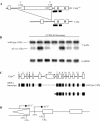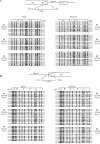Complex patterns of transcription at the insertion site of a retrotransposon in the mouse
- PMID: 15520464
- PMCID: PMC528799
- DOI: 10.1093/nar/gkh914
Complex patterns of transcription at the insertion site of a retrotransposon in the mouse
Abstract
Here we report that transcriptional effects of the insertion of a retrotransposon can occur simultaneously both upstream and downstream of the insertion site. We have identified an intra-cisternal A particle (IAP) retrotransposon in intron 6 of a gene that we have named Cabp (CDK5 activator binding protein). The presence of the IAP is associated with an aberrant transcript initiating from a cryptic promoter in the IAP, reading out into the adjacent Cabp gene sequence. The expression of this transcript is highly variable among isogenic mice within the C57BL/6J strain and so Cabp(IAP) can be classified as a metastable epiallele. As expected, the presence or absence of the transcript correlates with differential DNA methylation of the 5' LTR of the IAP. More surprisingly, in mice where the retrotransposon is unmethylated and presumably transcriptionally active, we find a number of short Cabp transcripts which initiate at the normal 5' end of the gene but terminate prematurely, just 5' of the retrotransposon. This is the first report of a retrotransposon having both upstream and downstream effects on transcription at the site of insertion and it suggests that alternative polyadenylation may sometimes be caused by a downstream convergent transcription unit.
Figures





References
-
- Deininger P.L. and Batzer,M.A. (2002) Mammalian retroelements. Genome Res., 12, 1455–1465. - PubMed
-
- Ostertag E.M. and Kazazian,H.H.,Jr (2001) Biology of mammalian L1 retrotransposons. Annu. Rev. Genet., 35, 501–538. - PubMed
-
- Han J.S., Szak,S.T. and Boeke,J.D. (2004) Transcriptional disruption by the L1 retrotransposon and implications for mammalian transcriptomes. Nature, 429, 268–274. - PubMed
-
- Rakyan V.K., Blewitt,M.E., Druker,R., Preis,J. and Whitelaw,E. (2002) Metastable epialleles in mammals. Trends Genet., 18, 348–351. - PubMed
-
- Duhl D.M., Vrieling,H., Miller,K.A., Wolff,G.L. and Barsh,G.S. (1994) Neomorphic agouti mutations in obese yellow mice. Nature Genet., 8, 59–65. - PubMed
Publication types
MeSH terms
Substances
LinkOut - more resources
Full Text Sources
Research Materials

